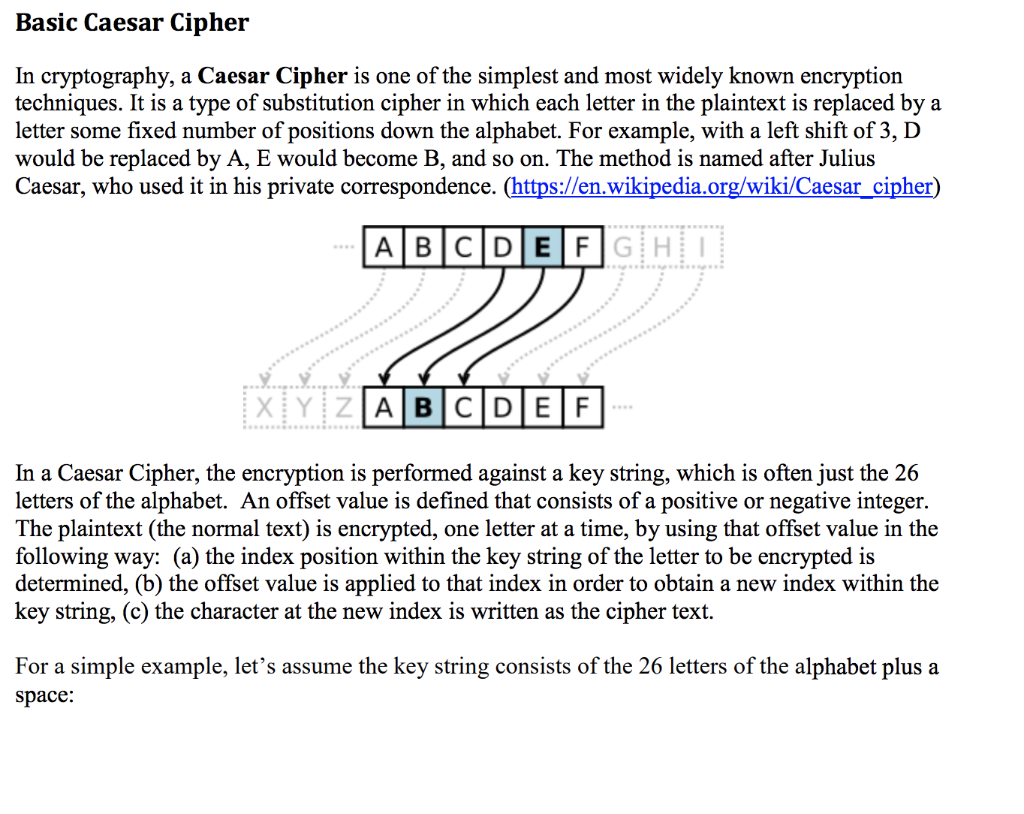

The encrypted message of this plain text is "WTAAD".ĭ n (x) = (xi - n) mod 26 Ciphertext: W → 22 Note that the Caesar cipher is monoalphabetic, so the same plaintext letters are encrypted as the same letters. Ciphertext: M → 12Įxample: 2 Use the Caesar cipher to encrypt and decrypt the message "HELLO," and the key (shift) value of this message is 15.Į n (x) = (x + n) mod 26 Plaintext: H → 07

If any case (D n) value becomes negative (-ve), in this case, we will add 26 in the negative value. We apply decryption formulas by character, based on alphabetical order. For example, "JAVATPOINT" has "A", encrypted by "D". We apply encryption formulas by character, based on alphabetical order.Į n (x) = (x + n) mod 26 Plaintext: J → 09 Plaintext: It is a simple message written by the user.Ĭiphertext: It is an encrypted message after applying some technique.Įxample: 1 Use the Caesar cipher to encrypt and decrypt the message "JAVATPOINT," and the key (shift) value of this message is 3. It means the message encrypted by this method can be easily decrypted. Let's take an example to understand the Caesar cipher, suppose we are shifting with 1, then A will be replaced by B, B will be replaced by C, C will be replaced by D, D will be replaced by C, and this process continues until the entire plain text is finished.Ĭaesar ciphers is a weak method of cryptography. The Caesar cipher is a kind of replacement (substitution) cipher, where all letter of plain text is replaced by another letter. For this reason, the shift cipher technique is called the Caesar cipher.

Julius Caesar used the shift cipher (additive cipher) technique to communicate with his officers. The Caesar cipher method is based on a mono-alphabetic cipher and is also called a shift cipher or additive cipher.
#CEASAR CIPHER HOW TO#
Once you learn how to build an encoder and decoder in a cipher as simple as this one, you'll be able to progress to more difficult ciphers and encryption schemes.The Caesar cipher is the simplest and oldest method of cryptography. This is just one of the many ways you can build a Caesar cipher in Python. This method takes the first argument as the plain alphabet and the second argument as the cipher. To do this, I used the str.maketrans() method. This is where the script might start looking a little more intimidating and complex. Next, I created a variable to tell Python how to transpose the message. I added this in to allow for flexibility if I wanted to shift the message by anything other than 13 characters. This means we can execute the function without even giving it the offset and it will, by default, use ROT13.

By default, it will shift by 13 characters. This variable tells the function how many characters the message must be shifted. This is the plaintext message that you want to encode. The function requires two variables to work.
#CEASAR CIPHER CODE#
The first line of code defines the function. Next, I wanted to create a function that would allow me to encode a message. I created a list in a variable called chars and added an uppercase alphabet and a lowercase alphabet. The first thing I did was create a variable that housed all of the possible alphabetic characters (upper and lower case). I created my script in Python 3.8 using P圜harm 2020.1 (Community Edition). There are many ways to write a Caesar cipher script in Python this tutorial goes over a script I wrote that works for me. Now that we have some basic knowledge of Caesar ciphers, let's get started on creating our encoder and decoder in Python! I've opted for Python 3.8 in this tutorial. There's no practical security use for Caesar ciphers they do not provide confidentiality or integrity of messages. Shifting the alphabet by 13 using a Caesar shift is also referred to as ROT13. For example, a Caesar cipher that shifts the alphabet by 13 means that A becomes N, B becomes O, C becomes P, and etc. A Caesar cipher is a method for encoding a message where letters of the alphabet are shifted, thus obfuscating the original message.


 0 kommentar(er)
0 kommentar(er)
